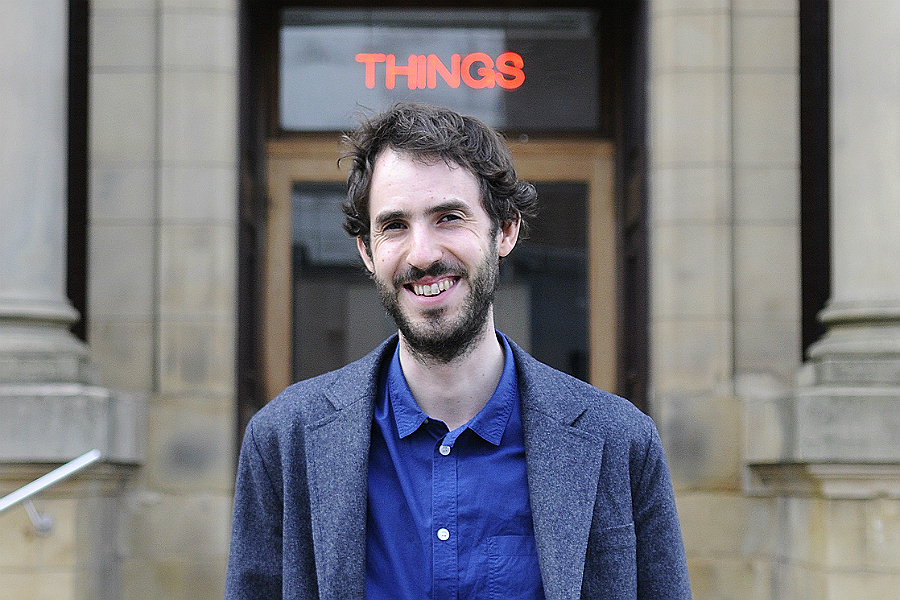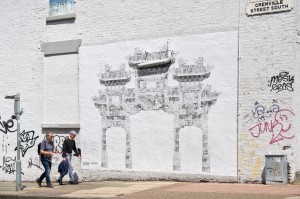New Arrival: Richard Parry

Having left the South Bank’s Hayward Gallery, Emma Sumner spoke to Richard Parry about his new role as curator, at Blackpool’s Grundy Art Gallery…
Richard Parry has worked on major exhibitions, including Tracey Emin’s retrospective, and managed projects with Hayward touring, bringing a wealth of knowledge and experience with him to his new role.
I went to discover what attracted him to Blackpool, what his plans are for the Grundy’s programme and how he sees his role within the sea-side town.
Emma Sumner: You’ve made the move from London and a world-renowned gallery for Blackpool’s lesser known Grundy Art Gallery. What was it that attracted you to move here?
Richard Parry: Firstly the space is really nice. It’s a beautiful grade two listed Edwardian Carnegie building with a very handsome interior. It was exciting to have this space to come to, but also I had been at the Hayward for five years in an Assistant Curatorial role and was looking for something to sink my teeth into and allow me to develop my own curatorial voice.
I had opportunities at the Hayward; for example I had curated an exhibition on Concrete Poetry, but this was a really exciting opportunity to develop that author narrative of exhibitions in a really interesting space. The other thing to mention is the context of contemporary art in Blackpool. The town has a very distinct, very interesting visual culture and visual heritage – and social heritage as well – and as a place for contemporary art it is extremely exciting as a curator and for artists. This has been a big draw too.
What is your vision for the space and were do you see your ‘curatorial voice’ taking the programme?
One thing that has been really striking for me and interesting is the relationship between popular culture and contemporary art and it is something I would like to explore in the programme through group and solo exhibitions. The other thing that is fascinating for me is the fact that we have a collection here. It’s quite an unusual slightly random collection, which goes back to when the gallery started in 1908 and the original bequest from the Grundy Brothers of thirty paintings. It’s a little bit random, but interesting for that.
We have works by people like Eric Ravilious and more contemporary works by artists like Lindsay Seers or Peter Liversidge [and] have just acquired work through the Contemporary Art Society; the permanent installation of Ruth Claxton’s Synthetic Worlds (Two Women) in the stairwell as well as Martin Creed’s work above the door.
Our collection is kind of surprising and interesting, it includes a vast collection of ivory figures, as well as odds and ends that you would not necessarily class as art. It’s this blurring for me that’s really fascinating.
You mention Blackpool’s visual culture and heritage and how contemporary art fits into this. How do you see the Grundy’s programme interacting with this contemporary arts scene?
Well Supercollider is a really exciting space run by Tom Ireland in the town which gives a platform for emerging artists… It’s a fantastic complement to the Grundy [which] is a much bigger space and our shows have a different complexity to them as a result of that; but totally, I’m interested to look towards working with artists from the region and the town.
I think the exhibitions will draw on the context of the town as a sight of popular culture and those triggers that you have here such as the fairground or the illuminations, but looking at these traits of popular culture in a surprising and not necessarily obvious way. It’s a background you can’t really get away from but it’s also one that’s really interesting. Obviously, I’m hesitant to be too literal about this in case I ruin the mystique a little bit!
Coming from London to the North West and Blackpool; a town where you are surrounded by many bigger cities with vibrant art scenes – such as Preston, Liverpool and Manchester – what are your views of what’s happening here now you’ve settled in?
Actually I’ve just written a piece for the a-n blog which is part of the Portfolio North West exhibition at the Bluecoat about critical writing in the north west. In the article I was discussing how – coming fresh to the region – I hadn’t thought about things in a regional way as contemporary art is such a global thing that thinks it’s bigger than a locality and the debates that are being talked about are beyond the constraints of place in a sense.
I’ve also been thinking about how geography determines an art scene as well and how those towns come together and how you have all of these big metropolises that are relatively close together but yet still quite far apart. So, what I was talking about with the writing is that blogs are a great way of connecting people … that are interested in culture and art as well as artistic communities that exist through the web.
Of course blogging is good as it’s a cheap to do and it’s a nice testing ground for people to get their ideas down on paper and to build their knowledge and skills. I suppose it’s a catalyst to a scene and its really important, and one thing I have been thinking about recently is the role of blogs and writing and zines, and this scene of art writing.
What is your role in this thriving scene?
The Grundy is a strong site, but I’m also interested to push publications in some way because not everyone can make it here all the time, so the Grundy has to function from afar in some way. It has to put on a great programme that is relevant so people want to come and see, that is listening to the art that is being made around it and beyond that as well. It has to be vital to the people that are here and who come to see the art, which is totally crucial.
I would really like to explore the different ways that we can do this either through exhibitions or events; we are doing a symposium for the Zoe Beloff which is a totally new thing. But also I’m looking at how we might use publications or writing of some kind on the website as a platform online – we are already on twitter which is a new thing.
What challenges do you feel you’re going to face going forward and what are you excited about? Since taking over what have you found to be the pros and cons of the job?
Coming from somewhere as massive as the Hayward, where you have a department for every single thing – development, marketing, press and technical teams as well as people to manage the building – here there is a team of three and a half of us and so a lot of the roles fold into one which is mine.
This is a definite challenge as you have to wear lots of hats all the time and have to juggle lots of balls at once but this has also been useful and exciting in its own way to be involved in all of these different fronts and to learn how everything fits together from a gallery perspective.
The simple challenge is getting to know the space and what works here and what people respond to and just building a programme from afresh. It has been great to get to know the team here, bouncing ideas around and having interesting people in the town such as Supercollider and other artists, and becoming part of that scene.
Emma Sumner
Zoe Beloff: DREAMLAND (read our review) continues at the Grundy Art Gallery until 2nd November





